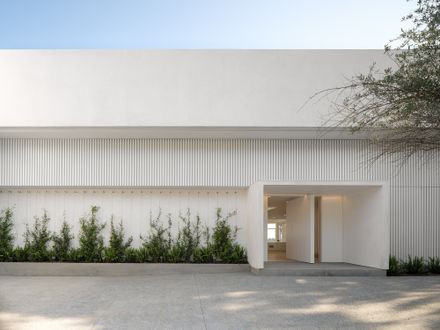MANUFACTURERS
FSB Franz Schneider Brakel, Advanced Archtiectural Grillework, Aquatica, INAX, Nexus 21, PRL Glass Company, Studco, Tektrim, The Pivot Door Company, Tungsten Royce, Wetstone Design Company
STRUCTURAL ENGENEERING
Ismail Associates Structural Engineers
LANDSCAPE ARCHITECTURE
Fiore Perttula Landscape Design
METAL FABRICATION
MKH
DESIGN TEAM
Carmen Suero, Janet Aparicio, Addeen Shahar, Connor Katalbas
BATHROOM, KITCHEN AND CABINETRY WORKS
AbitarGroup
PRINCIPAL AND LEAD DESIGNER
Pierre De Angelis
YEAR
2023
LOCATION
Los Angeles, United States
CATEGORY
Houses, Renovation
Text description provided by architect.
Architect Donald Luckenbill, a senior architect at the practice of Paul Rudolph, completed work on Oceanus House, situated atop Mount Olympus, in 1992.
Overhauling a modest home built on the property in 1975, Luckenbill doubled its footprint and completely changed its fundamental shape and style.
However, subsequent interventions over the years gradually eroded the house’s coherence, leading to the need for thoughtful modernization.
Good Project Company was initially engaged to re-imagine the interior finishes. Our goal was to modernize the space, while also returning a sense of cohesion.
To accomplish this, while only relying on finishes, a strategy was employed that would introduce materially reductive detailing aimed at emphasizing the houses’ most compelling features, particularly the striking horizontality of the structure, which appears to lightly float beyond the perimeter glass walls reinforcing the connection between the indoor and outdoor living areas.
Equally important was the delicate interplay between masses and voids, which added depth and character to the structure.
As the project evolved, the scope of improvements expanded significantly, encompassing the re-planning of key interior spaces as well as enhancements to the facade and site.
Adapting the original initial strategy of reductive detailing to this broader scope of work became a central challenge. The existing façade demanded a comprehensive modernization, with the caveat that the improvements did not impact the existing thermal envelope.
To address this, the team expanded the existing cornice and façade projections into three-stepped horizontal bands.
Each band assumes its own compositional autonomy: the lower band is defined by a series of metal cables that connect the facade to the landscape, the upper plaster band maintains the essence of the original stucco façade, and the middle band of white vertical slats mediates between the two.
The stepped banding further emphasizes the horizontality of the structure, maintaining consistency with the interiors, while providing an increased sense of privacy while redirecting the focus towards picturesque views of the Pacific Ocean and Downtown.

























